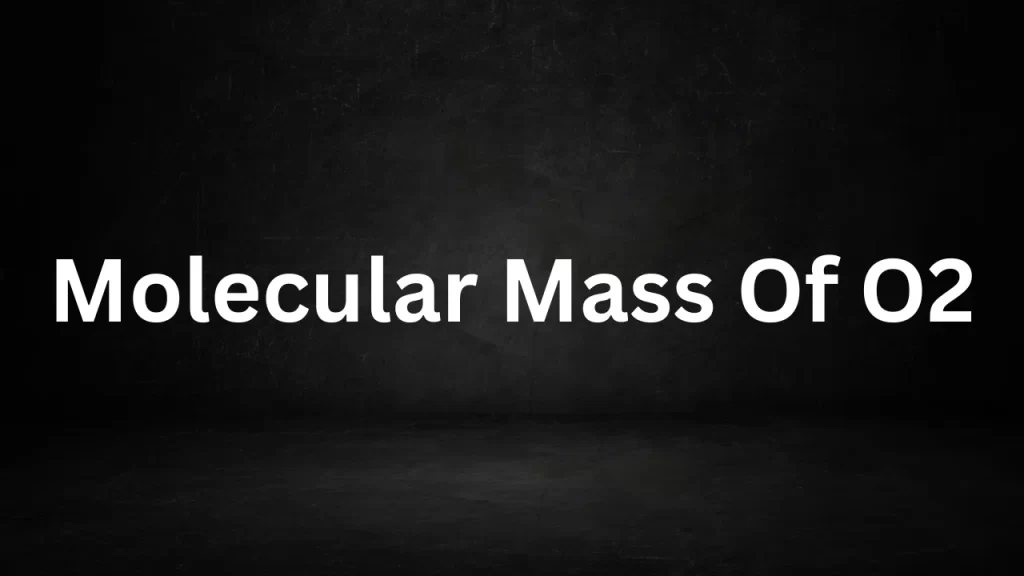Tag: mass oxygen
Molecular Mass Of O2
Molecular Mass Of O2: Oxygen, an essential element for life as we know it, exists primarily in the form of a diatomic molecule, O2, known as oxygen gas. In this article, we will explore the molecular mass of oxygen gas (O2), its significance in chemistry and biology, and its vital role in supporting life on Earth.

Molecular Mass Of O2
The Life-Sustaining Element: Oxygen
Oxygen, with the chemical symbol O and atomic number 8, is the third-most abundant element in the universe and the most abundant element in the Earth’s crust. It is a critical component of the Earth’s atmosphere, making up approximately 21% of the air we breathe. Oxygen is essential for respiration in most living organisms, serving as a key player in the processes that produce energy from food.
Molecular Structure of Oxygen Gas
Before discussing the molecular mass of oxygen gas, it’s important to understand its molecular structure. Oxygen gas consists of two oxygen (O) atoms bonded together, forming a diatomic molecule, O2. This diatomic molecule is the most common form of molecular oxygen found in the Earth’s atmosphere.
Molecular Mass of Oxygen Gas (O2)
The molecular mass of a compound, often referred to as its molar mass, is defined as the mass of one mole of molecules of that compound, measured in grams per mole (g/mol). To calculate the molecular mass of oxygen gas (O2), we sum the atomic masses of its constituent atoms:
- Oxygen (O) has an atomic mass of approximately 16.00 g/mol.
- Now, let’s calculate the molecular mass of oxygen gas:
- Molecular Mass of Oxygen Gas (O2) = (2 × Atomic Mass of Oxygen)
- Molecular Mass of Oxygen Gas (O2) = (2 × 16.00 g/mol)
- Molecular Mass of Oxygen Gas (O2) ≈ 32.00 g/mol
- So, the molecular mass of oxygen gas is approximately 32.00 grams per mole.
Significance of Molecular Mass in Chemistry and Biology
The molecular mass of oxygen gas is a fundamental value in both chemistry and biology. In chemistry, it is used for stoichiometry, chemical calculations, and the formulation of chemical equations. In biology, understanding the molecular mass of oxygen gas is crucial for comprehending the processes of respiration, where oxygen is used by cells to generate energy.
Conclusion
The molecular mass of oxygen gas (O2), approximately 32.00 g/mol, underscores the importance of this diatomic molecule in supporting life on Earth. From the air we breathe to the energy-producing reactions occurring within our cells, oxygen gas plays a central role in the biology and chemistry of our planet. Its molecular mass serves as a foundation for understanding the processes that sustain life and drive chemical reactions in the natural world.
Read More
- Molecular Mass of H2
- Molecular Mass Of NH3
- Molecular Mass Of Ch4
- Nitric Acid Molar Mass
- Molar Mass of Helium
Frequently Asked Questions (FAQs) Molecular Mass Of O2
Q1: What is the molecular mass of O2 (oxygen gas)?
A1: The molecular mass of O2 (oxygen gas) is approximately 32.00 grams per mole (g/mol).
Q2: Why is the molecular mass of oxygen gas important in chemistry and biology?
A2: The molecular mass of oxygen gas is important because it allows chemists to determine the mass of one mole of oxygen gas molecules, which is essential for stoichiometry, chemical calculations, and the formulation of chemical reactions. In biology, it is crucial for understanding processes like respiration, where oxygen is used by living organisms to generate energy.
Q3: Is oxygen gas the only form of oxygen in the Earth’s atmosphere?
A3: No, oxygen gas (O2) is the most abundant form of oxygen in the Earth’s atmosphere, making up about 21% of the air we breathe. However, there is also a trace amount of another form, ozone (O3), which is found in the ozone layer in the upper atmosphere and plays a critical role in protecting life on Earth from harmful ultraviolet (UV) radiation.
Q4: How is oxygen gas produced for industrial and medical purposes?
A4: Oxygen gas for industrial and medical purposes is often produced through processes such as fractional distillation of air or by electrolysis of water. In fractional distillation, air is cooled and compressed to separate its components, with oxygen being one of the products. Electrolysis of water involves passing an electric current through water to split it into hydrogen and oxygen gases.
Q5: What happens when oxygen gas is inhaled by living organisms?
A5: When oxygen gas is inhaled, it is transported by the circulatory system to cells throughout the body. Inside cells, oxygen is used in metabolic processes, particularly in the mitochondria, to generate energy through aerobic respiration. The waste product of this process is carbon dioxide (CO2), which is then expelled from the body when we exhale.